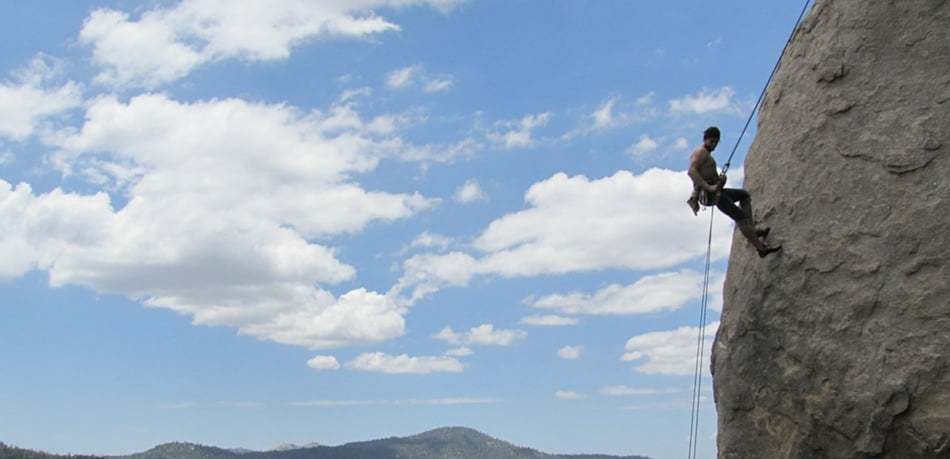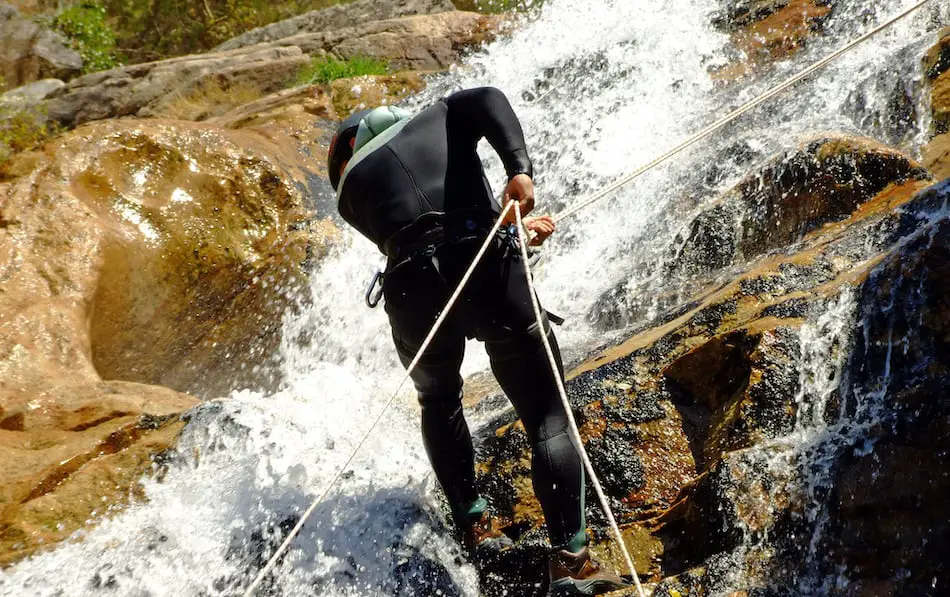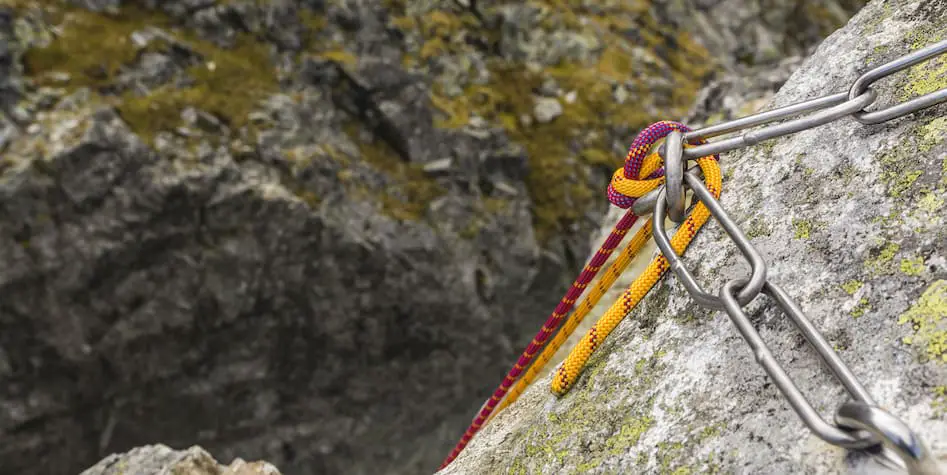
Climbing ropes are expensive. At $200, you don’t want to leave these things behind once you’re done rappelling down them. I’ve written the following guide to help you keep your rope with you at the end of the day!
So, how do you rappel and retrieve your rope? To rappel and retrieve your rope, you need to set up your rappel so that the rope isn’t knotted to the anchor. You can do this through either a two-strand rappel or a tagline rappel. Both of these will allow you to retrieve your rope after you’ve rappelled.
Retrieving your rope is important for more than one reason. Like I said, it’s obviously good because it prevents you from needing to buy a new rope every time you go. Additionally, it helps to keep the routes clean of old gear, and it allows you to use the retain the rope for your next rappel if you’re doing a multi-pitch or canyoneering. In the article below we’re going to talk about how each method works and then break down step-by-step how to perform each rappel.
Method One: Two-Strand Rappels

A two-strand rappel is one in which you have two pieces of rope, both feeding through your belay device, which you use to lower from. You can either do this with one rope that’s doubled up, or with two strands of rope that are tied together.
Two-Strand Rappels with One Rope
What it is: A method where you loop the rope through the rappel rings. Pulling on one side of the rope once you’re done allows you to retrieve it.
Pros:
- Simple to perform
- Safer, because it doesn’t rely on knots
- Less chance of your rope getting stuck
Cons:
- Because you’re folding the rope in half, you can only rappel half of the length that you can with the other two methods
A single rope passed through the anchors is maybe the most common form of rappelling that you’ll do. It’s the easiest to set up, the easiest to perform, and the easiest to get your rope back.
Retrieving your rope with a single-rope, two-strand rappel is as easy as follows:
- Set up the rappel so that the rope is hanging through your anchors.
- The midpoint of the rope should be positioned between the anchors, and both sides should be hanging down in a straight line so they’re parallel to each other.
- Ensure that both sides of the rope have a safety knot tied into them and are touching the ground (if it’s a single-pitch rappel).
- Perform the rappel.
- Once you’re on the ground, unclip your rappel device and untie both safety knots from each end of the rope.
- Once the knots are untied, simply grab one side of the rope and pull. The other side of the rope should be pulled upwards until it passes through the rappel anchors and falls down at your feet.
- (Important note: If you catch the rope within a fist-length of the end that was falling, your partner has to buy you a beer)
- Congratulations! You have now rappelled and retrieved your rope.
Two Rope
What it is: A method where you tie two ropes together, making sure the knot doesn’t pass through the anchor. Once at the bottom, you pull on the rope to retrieve it.
Pros:
- Allows you to extend your rappel
- Safer than a tagline method
Cons:
- More difficult to set up
- Requires that you bring more gear with you
Performing a rappel with two ropes is a little bit trickier, but it has a lot of the same mechanics as the single-strand method.
The big difference here is how you join the two ropes so that you can rappel off of them. The trick is to tie the ropes together with a wide knot. The knot should be wide enough so that it can’t pass through the rappel ring (Alternatively, you can make the not narrow enough that it passes smoothly between the rings, but this method is less common).
Note: Not every knot will work for this purpose! You need to make sure to use the right type of knot. For more information, check out my article here.
Once you’ve done this, you can thread the rope through the rappel anchors just like you would with a single-strand rappel. It’s important to memorize which side of the rappel rings the knot is sitting on!
After that is done, use the following steps to perform your rappel:
- Make sure the ropes are as equalized as possible. The knot should be sitting right against the rappel anchors.
- Double check that the knot isn’t going to pass through the anchors. If it does, you can find yourself in a pretty awkward position.
- Once this is done, connect your rappel device and complete the rappel.
- Once you reach the bottom, disconnect yourself from the rope.
- Untie the backup knot.
- Now comes the important part! Whichever side of the anchors the knot is on, pull the same side of the rope.
For example: at the top of the rappel, you check and see that the knot is on the left side of the rappel anchors. Once you get to the bottom, take the leftmost rappel strand and pull on it. The opposite side of the rope will get pulled upwards, before passing through the rappel rings and falling back to the ground.
Memorizing which side the knot is on is fairly important. If you get the wrong side, you risk pulling on the rope in such a way that will make the knot pass through one of the rappel rings. Now, ninety percent of the time, this won’t be an issue. However, you run the risk of the rope becoming caught between the two rings if the knot is unable to slide through either of them.
If this happens, you’re pretty stuck. You can try to climb back up to the anchors, although without a rope that could be pretty sketchy. Your only other alternative is to keep pulling on the rope from either direction in the hope that it will pass through one of the rings and allow you to pull it down again.
A good tip for avoiding this is to always make sure that you separate the ropes before pulling them. Ropes can get twisted and tangled during a rappel, and it’s not always that easy to tell which is which from the bottom of a climb. By pulling them apart to the point where yiou can clearly see each rope and which side it’s attached to, you mitigate the risk of accidentally pulling on the wrong strand.
Method Two: Tagline Rappels

What it is: A method where you perform a single-strand rappel and then use a second, smaller rope (like paracord) to pull down the rope once you’re done.
Pros:
- Requires less gear than a two-rope rappel
- The most viable option if you’re rappelling multipitch
Cons:
- Hardest to set up
- Most dangerous method
The second method for rappelling and being able to retrieve your rope is called a tagline rappel. A tagline is performed when you rappel off of one rope, but you use a second, smaller rope tied into it that allows you to pull it down once you’ve reached the bottom.
On the surface, this sounds very similar to what we were just talking about in terms of a two-rope rappel. There’s one key difference, however: with a tagline rappel, you only rappel off of one of the ropes. The second rope (the tagline) is usually a piece of cord or string that’s too thin to be trusted with your bodyweight.
Other than that, the setup for the rappel is very similar to what we just walked through in the two-rope rappel. There are a couple of important things to note:
- The thicker of the two ropes, which you’ll be rappelling from, must be the one to pass through the anchors. This will allow the knot to pull against the rappel ring when you weight the rope.
- In this method, you need to be extra careful to make sure that your knot won’t pull through the rappel rings. In a two-rope rappel, doing so was an inconvenience; with a tagline rappel, it’s a death sentence.
To perform a tagline rappel, use the following steps:
- Pass the rappel rope through the anchors.
- Tie it to your tagline using the proper knot and/or blocking mechanism to ensure that it stays in place.
- Clip yourself into the rappel rope.
- Complete your rappel and unclip yourself.
- Untie the backup knot at the end of the rappel line.
- Pull on the tagline. This will draw your rappel line up and through the anchor, where it will then fall down to be caught.
Conclusion
So there we go! There are two main methods for being able to rappel and retrieve your rope. The main thing you need to be aware of is to never secure your rope directly to the anchors, as this will make it impossible to retrieve. Instead, use one of the above methods (two-strand rappels or a tagline rappel) to do so.
As always, the advice you find on this blog shouldn’t be the only information you get. Have a certified guide train you in any new techniques before you try them out in the wilderness.
Stay say and have fun!
